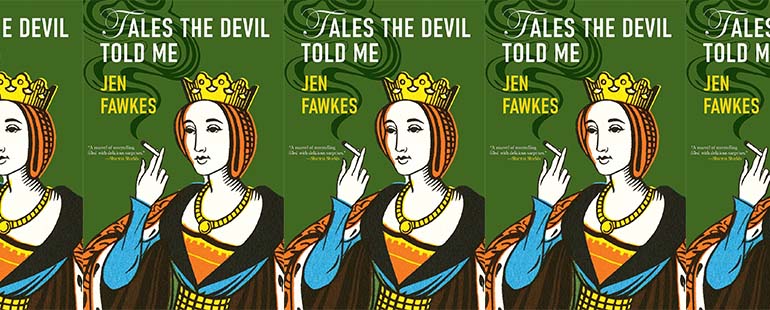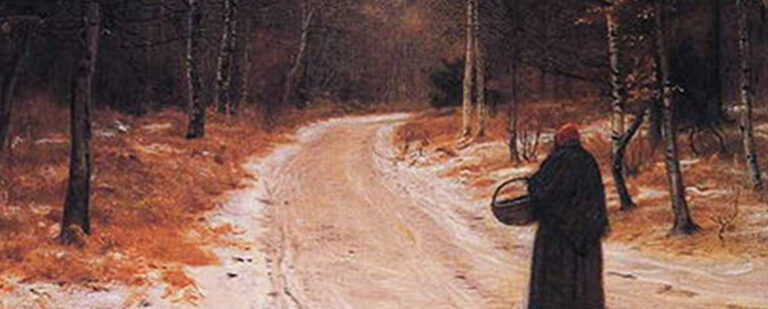Villainy and Epiphany in Tales the Devil Told Me

The early aughts could be called the Golden Age of the villain. In the last two decades, characters as varied as Maleficent, Darth Vader, and the Joker were resurrected and given starring roles, as well as the space to explore their origins and psyches, even as they straddled the line between antihero and outright villain. Why this fixation on the interiority of villains? Is it cultural zeitgeist, or are writers and audiences simply savvy enough to no longer believe that characters—heroes or villains—are that one-sided? Whatever the reason, villainy continues to inspire, whether it’s Nurse Ratched starring in her own series or Circe getting a complicated backstory, and the urge to excavate these characters shows no signs of abating.
In her latest short story collection, Tales the Devil Told Me, out last week, Jen Fawkes adds to the canon with twelve tales of literary villains, from Claudius to Mrs. Danvers, resulting in a book that is surprising, fun, and deeply felt. Winner of the Press 53 Award for Short Fiction, this collection assembles a motley cast of miscreants and goes far beyond their Hollywood origin stories. Fawkes casts backwards and forwards in time, and sometimes comes at her subjects from an angle, as she does in “Never, Never,” narrated by Captain Hook’s stepson who longs to understand the pirate-turned-postal-worker who has married his mother. Fawkes’s stories don’t simply long to provide motivation for a character’s badness, although on occasion they do that, but rather her collection is united around characters suffering from pervasive loneliness and longing for love—two human qualities anyone, villain or victim, could understand.
A longing for love, however, taken to its extreme, can cause characters to behave in bizarre and disturbing ways, and Fawkes explores the often thin and precarious line between love and selfishness. Her characters frequently confuse love with hunger, a thematic note she plays to grim effect. In “A Moment on the Lips,” Polyphemus the Cyclops so loves Odysseus and the other tiny humans he finds in his cave—he calls them tender, like miniature gods—that he picks them up, dashes their bodies against the stones, and devours them whole. The unnamed German baker in “Tiny Bones” likewise experiences an overwhelming urge to eat the hungry children who wander into her gingerbread house in the woods. She explains away her insatiable craving as only an instinct for self-preservation, though the reader knows she’s in fact been doomed to reenact multiple traumas she’s suffered, again confusing longing for love with longing for something else. “It isn’t about hunger or gluttony or even boredom,” Polyphemus says, “it’s about love. About inviting what you love inside . . . Ensuring that it remains with you forever.”
Fawkes has a keen sense also for how love can get twisted into a need for possession. In the opening story, “Demerol, Demerol, Benzedrine, Schnaps,” we find a lonely, drunken Rumpelstiltskin so hungry for love he’s convinced a desperate single mother to give up her child to him, only to question his motives seconds before he is cleaved in two. He asks himself whether, in seeking to take the child from his mother, his desires were actually “Something sinister merely masquerading as love.” This premortem epiphany perhaps points to the function villains play for Fawkes: as entrées into a discussion about the role of the nemesis in literature, and an insight into how, stripped of their opposing hero, a villain is free to examine their life and change, pivot from badness to goodness, or back again. Some take this opportunity and soar; others refuse and drown in their own tragic fates.
In another flip, it is King Hamlet, not Claudius, who is the villain in “The Tragedie of Claudius, Prince of Denmark.” A man clearly suffering from homicidal compulsions, King Hamlet murders his Queen’s dog, Yorick the fool, and seventy-seven others whose bodies are buried on the grounds of Elsinore. Claudius can see what must be done, and is even encouraged by Queen Gertrude, and yet he resists killing his brother, saying there is no evidence against the King. He finally relents upon learning that the King plans to murder him as well, reluctantly tipping poison into the sleeping King’s ear. It is at this point, when Hamlet returns from abroad and the Shakespearean drama unfolds, that Claudius feels uneasily that “This scene had been conceived of by another. That he was merely a character . . . being manipulated by some invisible hand.” As Claudius and the reader watch the deaths of Polonius, Ophelia, Gertrude, and the rest, Fawkes traps the well-intentioned Claudius in his role and denies him an alternate ending perhaps as punishment for not having spared his brother, or perhaps just to remind us that sometimes villains are as much victims of circumstance as anyone else.
If absolution is denied Claudius, it is freely given to J.M. Barrie’s Captain Hook in “Never, Never.” Narrated by Hook’s teenaged stepson, “Never, Never” is the story of Hook’s second act, wherein the retired pirate sits for the Civil Service Exam and takes a job with the Post Office. The story begins as a domestic drama of the why-did-Mom-have-to-remarry variety but soon morphs into a touching portrait of the aging pirate as a doting husband and dispenser of wisdom. When the subject of Peter Pan comes up, Hook says he realized at the age of forty that he didn’t hate the boy for cutting off his hand and feeding it to a crocodile, but for the fact that he couldn’t grow up. It was this epiphany that finally allowed him to quit his life of piracy and join the landlubbers. The stepson grows up and eventually joins the pirating life himself, even meeting Peter Pan once by accident. Pan says he cannot remember Hook, but he is struck by a photo of the stepson’s mother, going on about “how pretty she was and how nice she no doubt smelled and how very lucky I was to have her,” and we see that the longing for love in this case has been transferred to the putative hero, that the villain in this story is not the bloodthirsty pirate, but whatever magic arrests Pan forever in motherless childhood.
Fawkes resists the temptation to expound on villainy as a dramatic principle, preferring to let her stories speak for her. But in the case of “Dear Ahab,” a letter penned by the great white whale to his nemesis, she allows her hand to tip just briefly. “I was a great white backdrop,” the whale writes, “against which things stood in shadowed relief, a canvas onto which you could splash your vitriol.” Villains are symbols, she seems to be saying, standing in for everything we loathe and fear. Arthur Fleck in The Joker symbolized white male anger for many critics of the 2019 film, while Elphaba, the Wicked Witch of the West in Gregory Maguire’s 1995 novel, Wicked, has come to symbolize the misunderstood outsider-turned-villain for millions of Broadway fans.
A villain who appreciates his own existence as a symbol is a rare achievement and makes the often tragic fates of Fawkes’s characters even more poignant, aware as they are of being foils for some greater purpose, lights positioned only so that other characters may glow brighter. The epiphanies, when they come, are sweeter still for having come from characters who have them despite knowing they are probably locked into a storyline out of which they may not escape. Fawkes has done her villains a great service then, allowing them, prisoners that they are, the ability to have a few last words.


